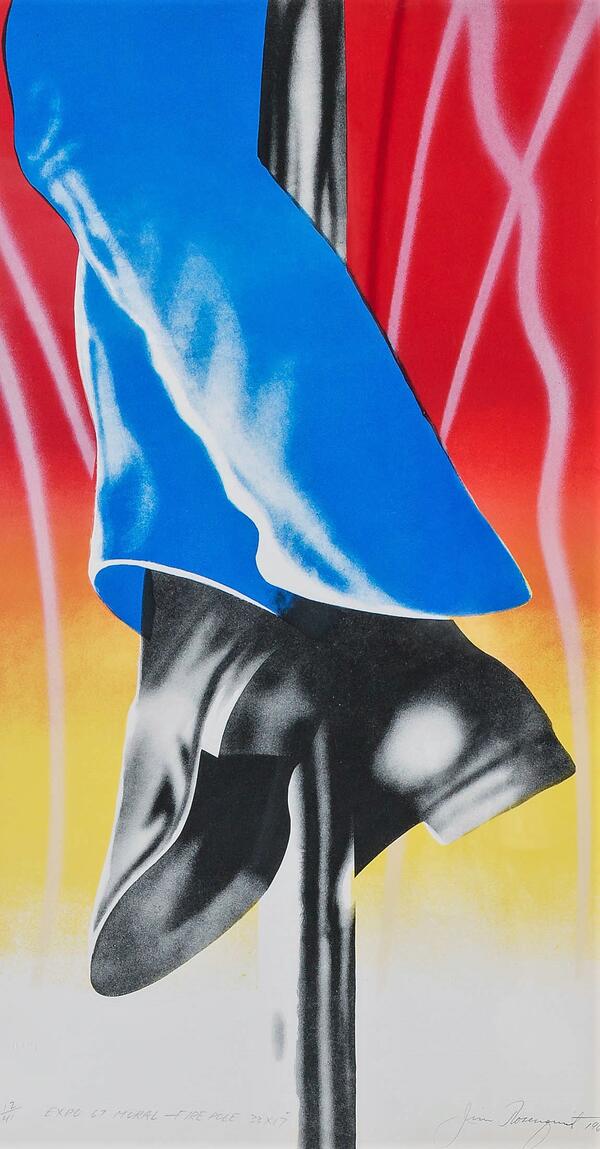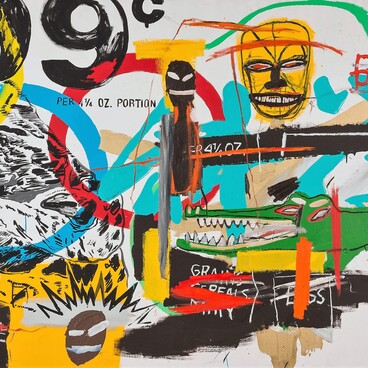The work “Fire Pole” from the Ludwig museum’s collection is a silkscreen mural created by James Rosenquist for the American Pavilion at the Montreal World Exposition in 1967.
James Rosenquist, whose works are housed by the Marble Palace of the Russian Museum, was one of the representatives of the Pop Art movement along with Andy Warhol.
The artist was born on November 29, 1933, in Grand Forks, North Dakota. He studied at the Minneapolis School of Art, and from 1952 to 1954 James Rosenquist attended the University of Minnesota, where he studied art under a prominent abstract expressionist Cameron Booth. In 1955, Rosenquist moved to New York, where he earned a scholarship to the Art Students League and studied under the tutelage of Edwin Dickinson and George Grosz.
Rosenquist started as a commercial sign painter. This career ended when he moved into a studio in Lower Manhattan, where he gradually befriended other upcoming artists of the era such as Ellsworth Kelly, Robert Indiana, Agnes Martin, Jasper Johns, Robert Rauschenberg, and Barnett Newman throughout the 1960s.
In 1957, he joined the Graphic Arts International Union and soon became the lead artist for one of the design companies in New York, painting billboards in Times Square and Fifth Avenue.
In 1961, Rosenquist decided to dedicate his life to painting. The artist’s first solo exhibition took place at the Green Gallery in New York in 1962. He became famous for his work at the Montreal World Exposition of 1967.
The “Fire Pole”, that was presented in Montreal, is distinguished by an unusual composition and minimalism. The artist depicted a firefighter sliding along a pole as if floating above the ground. The seven-meter panel was composed of plastic film to achieve the effect of the image suspended in the air. The transparent film creates the impression that the picture was painted in the air with no support, making the work the center of the viewers’ attention.
Rosenquist’s paintings are notable for their advertising imagery and commercial color palette. The artist depicted people only in fragments by painting eyes, a wide American smile, part of a shoulder, hand, or legs in polished shoes. Inanimate mass consumption items and equipment, together with human faces and bodies, filled the bright, monumental and yet aggressive paintings by Rosenquist.
In his 2009 book of memoirs, Rosenquist reminisced about his youth, working with street painters who had to place advertisements on huge billboard stands. The original picture was divided into squares, and each painter got a fragment, be it a part of a face or an object or a few letters. This experience would later inspire the artist to use this approach as a means of expression in his own works.
James Rosenquist, whose works are housed by the Marble Palace of the Russian Museum, was one of the representatives of the Pop Art movement along with Andy Warhol.
The artist was born on November 29, 1933, in Grand Forks, North Dakota. He studied at the Minneapolis School of Art, and from 1952 to 1954 James Rosenquist attended the University of Minnesota, where he studied art under a prominent abstract expressionist Cameron Booth. In 1955, Rosenquist moved to New York, where he earned a scholarship to the Art Students League and studied under the tutelage of Edwin Dickinson and George Grosz.
Rosenquist started as a commercial sign painter. This career ended when he moved into a studio in Lower Manhattan, where he gradually befriended other upcoming artists of the era such as Ellsworth Kelly, Robert Indiana, Agnes Martin, Jasper Johns, Robert Rauschenberg, and Barnett Newman throughout the 1960s.
In 1957, he joined the Graphic Arts International Union and soon became the lead artist for one of the design companies in New York, painting billboards in Times Square and Fifth Avenue.
In 1961, Rosenquist decided to dedicate his life to painting. The artist’s first solo exhibition took place at the Green Gallery in New York in 1962. He became famous for his work at the Montreal World Exposition of 1967.
The “Fire Pole”, that was presented in Montreal, is distinguished by an unusual composition and minimalism. The artist depicted a firefighter sliding along a pole as if floating above the ground. The seven-meter panel was composed of plastic film to achieve the effect of the image suspended in the air. The transparent film creates the impression that the picture was painted in the air with no support, making the work the center of the viewers’ attention.
Rosenquist’s paintings are notable for their advertising imagery and commercial color palette. The artist depicted people only in fragments by painting eyes, a wide American smile, part of a shoulder, hand, or legs in polished shoes. Inanimate mass consumption items and equipment, together with human faces and bodies, filled the bright, monumental and yet aggressive paintings by Rosenquist.
In his 2009 book of memoirs, Rosenquist reminisced about his youth, working with street painters who had to place advertisements on huge billboard stands. The original picture was divided into squares, and each painter got a fragment, be it a part of a face or an object or a few letters. This experience would later inspire the artist to use this approach as a means of expression in his own works.



